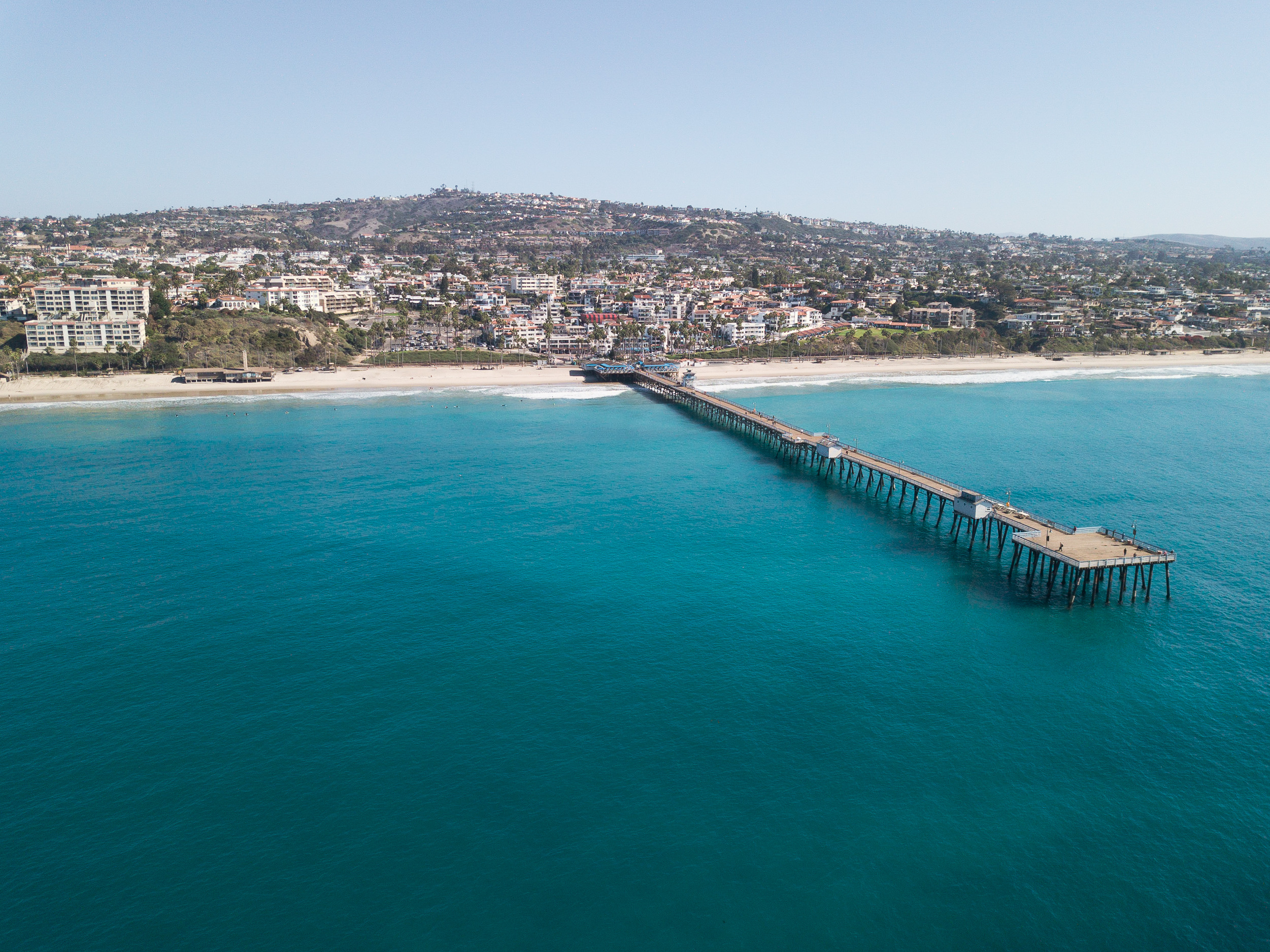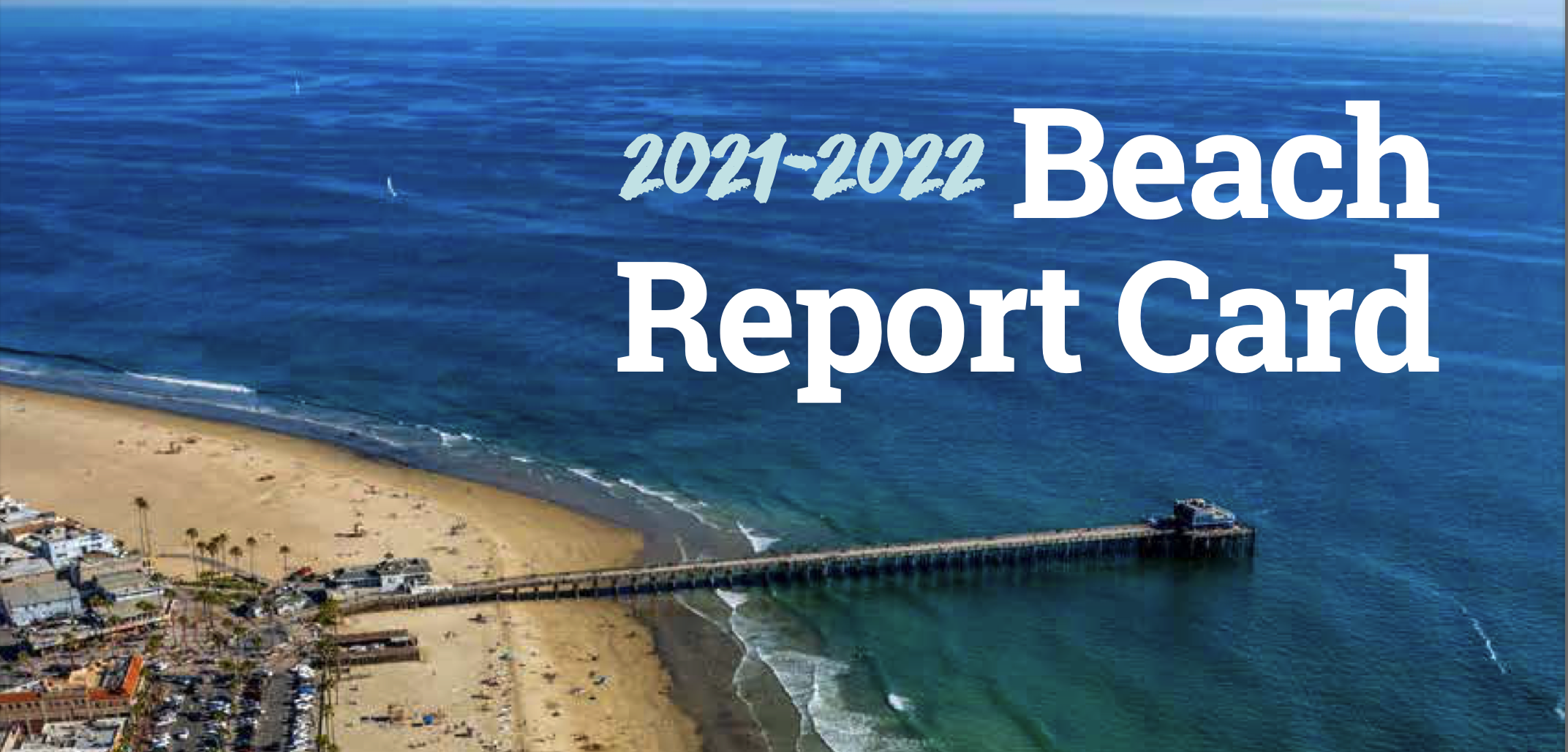OC Beaches Shine in Latest Heal the Bay Report Card
June 22, 2022
 San Clemente Pier.
San Clemente Pier.
As detailed in the 2021-2022 Beach Report Card just released by Heal the Bay, from Seal Beach to San Clemente, there are plenty of “A grade” beaches in Orange County for you to visit and feel the sand between your toes. That is because one could argue in looking at the latest report card, that Orange County beaches have never been better. In fact, 19 of the 51 beaches that made Heal the Bay’s “West Coast Honor Roll” this year are in Orange County.
Orange County beaches represent the end of watersheds that extend from the Santa Ana, San Bernardino, and San Jacinto mountains to the shore. As water flows through our watersheds, runoff from streets and other hard surfaces can carry pollutants into waterways. Most runoff does not get treated before entering our waterways via the storm drain system. This differs from the sewer system which treats water from our sinks, toilets, and showers. Pollutants, especially bacteria from pet waste and other sources flowing to beaches, can affect human health and cause beach closures.
H2OC has partnered with other agencies and organizations over the past several years to monitor beach water quality, prevent pollutants from entering our storm drains, and protect our water resources – including our many beaches. H2OC is very proud of the significant improvement in beach water quality achieved over the past several years and continues to take actions protective of water quality every day.
Beach Performance
How do we know beach water quality in Orange County has improved? By collecting a lot of data! This data is summarized in Heal the Bay’s 2021-2022 Beach Report Card, which assigns beaches a grade of A – F for three specific categories: summer dry (water quality in the summer months on a non-rainy day), winter dry (water quality in the winter months on a non-rainy day), and wet weather (water quality after rain). These grades are determined by analyzing state, local, and Tribal water quality data for various indicator bacteria. If the levels of these bacteria are too high, a health advisory is posted at that location. The less health advisories a beach has throughout the year, the better the grade.
How did we do in 2021 – 2022? According to Heal the Bay’s analysis, Orange County’s beaches received glowing grades! Healthy waterways are critical to protecting surfers, swimmers, and other water recreators from getting sick and for protecting aquatic life. Let’s dive in to review our report card and explore what H2OC has been doing to keep our waterways healthy.
- 19 Orange County beaches made the West Coast Honor Roll – more than any other County.
- 99% were graded A or B during summer dry weather (2% higher than the five-year average of 97%).
- 95% were graded with an A or B in winter dry weather (1% higher than the five-year average of 94%).
- 66% were graded with an A or B for wet weather (14% higher than the five-year average of 52%).
These grades are even more impressive when you consider that there was not a single reported illness in Orange County this year due to beach water contact recreation.
Water Quality Efforts
Orange County’s terrific beach grades are the result of collaborative efforts across the County to prevent and reduce the impacts of pollution from urban runoff. Through our partnerships, we’ve addressed 1,321 reported pollution incidents through our 24-hour pollution hotline and website in the past year alone. We are also partnering with water agencies to leverage water use efficiency strategies to reduce runoff from landscape irrigation and we coordinate closely with wastewater agencies in responding to sanitary sewer overflows.
Weekly beach water quality monitoring is performed at 136 sites through a coordinated unified program managed by OC Public Works, OC Health Care Agency, OC Sanitation District, and South OC Wastewater Authority. The monitoring program helps us track beach conditions and ensure they remain safe for swimmers and surfers.
In addition to these efforts, H2OC is utilizing the latest science and technology to proactively identify sources of human-related bacteria in urban runoff. Several source investigations have been undertaken in South Orange County in the last two years and a similar approach has just been initiated in the Newport Bay Watershed.
Other pollution efforts helping to protect beach water quality include targeted coastal dry weather storm drain diversions and treatment systems. The diversions route dry weather flows from the storm drain system directly to the sanitary sewer system, while onsite treatment systems at several beaches utilize ozone or ultraviolet light to neutralize bacteria in dry weather runoff. A guided tour of the numerous strategies being utilized in South Orange County to address bacteria is available here.
All these efforts no doubt contribute to the excellent grades for Orange County beaches, but our work extends far beyond the coast! All throughout Orange County, thousands of best management practices such as vegetated swales, pervious pavement, and trash capture devices have been installed to prevent pollutants from entering our waterways. These efforts have contributed to a reduction in bacteria loading of up to 98% in the Aliso Creek Watershed alone.
What You Can Do
We can’t protect our beaches and waterways without the help of everyone that lives, works, and plays in Orange County. So many of you have kept our waterways in mind when walking your pet, exploring our many beaches and parks, or watering your lawn. From all of us at H2OC, we extend our gratitude.
If you are looking to join your friends and neighbors in making sure our waterways stay sparkling, here are some great ways to get started:
1. Clean your yard. By sweeping and disposing of debris, picking up pet waste, and storing household hazardous materials indoors or under cover, you can prevent the rain from taking contaminants into the storm drain system.
2. Keep waste bins and compost piles covered. When these bins are covered, wind and rain can’t blow trash and other waste into the storm drain system. This simple act can also increase the longevity and effectiveness of our drain inserts.
3. Skip watering before, during, and after a rain event. Overwatering is wasteful and can cause runoff to flow into the storm drain system, picking up pollutants along the way. By checking the forecast and adjusting your watering schedule, you can save water while protecting our waterways from unnecessary runoff pollution.
Keep Our Beaches Clean
Our beaches are some of our County’s most prized resources, and we’re proud to help keep them clean, healthy, and safe. With your continued commitment to protecting our waterways, we can shine in the Heal the Bay Beach Report Card every year!
To learn more ways you can protect our waterways, click here.
Thank you for helping us protect our beautiful beaches from pollution!
